Nikon D90 Review
Review Date: October 13th 2008
Author: Zoltan Arva-Toth
Review unit kindly provided by http://www.ccsfoto.hu/
Leave a comment about this Review
|
Introduction
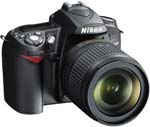
This summer, two years after the introduction of the D80, Nikon announced its successor, the D90. This new DSLR camera inherits its older brother's outer dimensions, power source, 11-point AF module and most of its external controls, but adds a newly developed 12 megapixel CMOS sensor, EXPEED image processor, and a bigger and much higher-resolution rear LCD screen. The D90 also features a slightly improved viewfinder coverage, 3D focus tracking, ultrasonic sensor cleaning, 50% faster burst shooting, a larger buffer, Active D-lighting, in-camera raw development, an expanded ISO sensitivity range, HDMI connectivity, geotagging by way of an optional accessory, Live View with Face Priority AF – and on top of all that, it's the first DSLR ever produced to offer a movie mode! Zoltan Arva-Toth found out how the new Nikon D90 performed out in the field.
Compare Prices
Support PhotographyBLOG: Buy the Nikon D90 from one of our affiliate retailers:Ease of Use
Photographers who own or have at least handled a Nikon D80 will instantly feel at home with the D90, as the new camera has the exact same dimensions and almost the same shape as its predecessor. D70 owners who gave the D80 a pass will, however, likely notice that the right-hand grip of these cameras is actually somewhat less comfortable than on the D70. If you are finding that your little finger has a less secure place on the D90 than it had on the D70, consider purchasing an MB-D80 battery grip along with the camera. This is, by the way, the same vertical grip that fits the D80 too, so those who have already bought one for their D80 can use it on the D90 as well.
The control layout of the D90 is also very similar to the D80, with only the dedicated Live View button and an info button to the bottom right of the screen being completely new. The OK button has moved to the centre of the four-way pad, and the focus selector lock has been changed from a slider to a switch, but that's it really – the other changes are cosmetic only, affecting the shape of buttons well known from the D80, and the colour of their labels. The similarities extend to the power source and the recording medium as well. The D90 runs on the same proprietary EN-EL3e Lithium-ion battery as the D80, and records images on SD/SDHC cards. We would have liked Nikon to add a second card slot to accommodate CompactFlash cards as well, but unfortunately it didn't happen.
So, what's new then? Quite a lot, actually. For starters, the D80's ten megapixel CCD has been superseded by a 12 megapixel CMOS chip capable of providing a Live View feed, recording video and capturing full-resolution stills at 4.5 frames per second, up from 3fps in the D80. Even more importantly, the sensor can now clean itself, by way of high-frequency vibrations that will, at least in theory, shake off any non-adhesive dust particles that may have settled on the low-pass filter during a lens change. You can specify, via an option in the Setup menu, whether you want sensor cleaning to take place at shutdown, startup, both or neither, with the default being 'both'. I was very pleased to learn that the cleaning process had no practical impact on startup times, which were near instant. The new image sensor is complemented by a more powerful processing engine and a larger buffer as well.
While the above changes remain invisible until you put the camera to actual use, there is one development that will be very hard to overlook for anyone taking even a casual look at a D90: the rear screen. The D80 already had a nice, big 2.5” TFT LCD with a resolution of 230,000 dots, but it pales in comparison with the D90's three-inch, 920,000-dot monitor. On the new camera, the screen is used not only to navigate menus and to review pictures, but can also act as a secondary status display, facilitating the transition for former D50/D40/D60 owners who are not yet used to having a top-mounted status LCD on their cameras. And of course it's also the rear screen that provides live view for capturing both stills and movies. For this reason, we were a little disappointed to learn the monitor was still fixed, lacking articulation of any kind.
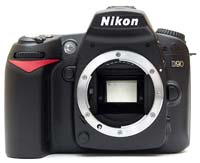 |
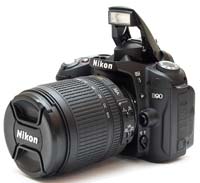 |
| Front | Pop-up Flash |
Lest you panic that you have to hold the D90 at arm's length to frame your shots, I'll hasten to add that, at least as long as you are taking stills, it is just an option. You still get a true optical TTL finder as well, and it's a very good one to boot. The difference between the D80's and the D90's finders is less obvious than the difference between their LCDs, with the magnification being the same, and only the frame coverage being marginally better, at 96% vs. 95%. The 11 auto-focus points are permanently marked on the focusing screen, whereas the compositional grid lines can be called up via a menu option. Three warning signs – reminding you that you are in black-and-white capture mode, the battery is running low or you have forgotten to insert a memory card – may also appear in the form of overlaid icons when appropriate. Below the finder is a traditional monochromatic status bar that is only slightly different to the one seen in the D80.
As stated above, the D90 has eleven auto-focus sensors, out of which only the central one is a cross type. The other ten are of the line variety, consequently being only sensitive to either vertical or horizontal detail, but not both. In practice, this did not turn out to be a real problem, with the camera typically locking focus on the subject easily, no matter which AF point was selected. Be aware though that the default AF area mode is 'auto-area' in most of the scene and exposure modes, including P, A, S and M as well. In auto-area mode it is the camera, rather than the photographer, that chooses which AF point(s) to use, which is usually not desirable. You can change this via Custom Function 'a1', to single-point, dynamic-area or 3D-tracking AF. Single-point AF is what you will want to use most of the time, as it gives you the opportunity to specify which of the 11 auto-focus sensors should be engaged. In the viewfinder, the active AF point appears in brackets, which are easy to see. Selecting the active AF point is done by way of the four-way pad, unless the focus selector lock is in the L (=Locked) position. Be aware of one thing though: after the auto meter-off delay specified in Custom Function 'c2', the camera goes into a sort of sleep mode, in which you cannot set the shutter speed, the f-number or indeed the active AF point until you half-press the shutter release button to wake the camera fully up.
If you select dynamic-area AF, you can also specify an AF point, but the camera “will focus based on information from surrounding focus points if subject briefly leaves selected point”, as the user guide puts it. This is the default AF area mode in the Sports scene mode. More interesting is the 3D focus tracking feature, which has been cascaded down from higher-priced models, making the D90 the first mid-range DSLR to offer this option. Basically what it means is that you specify the focus point that is right on your subject, then the camera will attempt to track this subject as it moves across the frame, using whichever AF point it deems appropriate in any given moment. Apparently, the camera does this using colour information from the 420-segment RGB metering sensor to identify the subject. In the field, it was quite astounding to see 3D focus tracking in action.
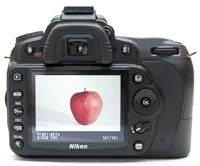 |
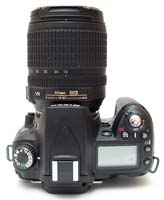 |
| Rear | Top |
The modus operandi of the auto-focus system can also be specified by the photographer. There is nothing new here: AF-S is for stationary subjects – an AF assist lamp is available for use at close range in low light –, AF-C is for moving ones, while AF-A is the best of both worlds. Cycling through these modes is done by holding down the dedicated AF button on the top plate, and turning a control wheel. Note that some of the AF area modes, namely dynamic area and 3D focus tracking, will only work the way described above if you are either in AF-A or AF-C. The camera also allows you to focus on your subject manually. To do this, turn the AF/MF switch, found below the lens release button, to the position marked with an 'M', and use the MF ring on the lens to focus. This option will come in especially handy when shooting movies.
One area of photography that the D90 is particularly well suited to is flash photography. The camera has a built-in speedlight with a guide number of 17 (in metres) at ISO 200. In auto mode, this flash will pop up automatically if the camera thinks it's necessary, but in most other exposure modes, it is left to the photographer to decide whether to use it or not. This little flash can not only be used as an emergency light source or a fill light, but also as a commander for up to two groups of wireless flash units. In such a setup, you can specify if you want the on-board flash to give only a signal to fire off the wireless slaves or also to provide some fill light. It is also possible to chose the mode of operation (TTL, Auto or Manual) for one or both of the slaved flash groups, and even to regulate their output from the camera. Compatible flashguns include the SB-900, SB-800, SB-600 and SB-R200 flash units. I tried this mode out with a single SB-600 as the slave, and it worked consistently well.
One of the extras the D90 offers over the D80 is Live View off the main sensor. While other manufacturers have been implementing this feature across their entire DSLR line, Nikon has, until now, reserved it for their higher-priced models, including the D300, the D3 and the D700. With the D90, Live View has arrived to less well-heeled Nikon fans as well. And while on their other cameras, LV was one of the drive mode options, it now has its own dedicated button. Live View is either delivered on the high-resolution rear monitor or on any LCD panel or plasma screen connected to the camera via an HDMI cable. There is a red rectangle in the middle, which you can move practically anywhere in the frame. When in manual focus mode, you can magnify into this rectangle in five steps simply by repeatedly pressing the button marked with a loupe icon, but this magnification seems to be interpolated rather than real. This means that you cannot see detail down to the pixel level, unlike with many competing cameras, which was a disappointment given the excellent LCD screen.
Thankfully, MF is not the only focusing option in Live View, at least as long as you are taking stills. Previous LV-capable Nikon DSLRs had two AF modes in Live View, dubbed “hand-held” and “tripod” modes. The first used the phase-detect AF sensors with lots of mirror slapping, while the second employed the contrast-detect method, and was extremely slow. In the Nikon D90, only the second mode remains. And while it might be speedier than the “tripod” mode of the D300, D3 and D700, it is still among the slowest we've encountered, typically taking between 2 and 3 seconds to lock focus on a subject in good light. For the first time in a Nikon DSLR, this contrast-detect AF mode can also be used in connection with face detection. 'Face-Priority AF' had no problem finding and keeping track of human faces as long as they were facing the camera, but acquiring focus was another story – very, very slow. The system can detect up to five faces and will attempt to focus on the one closest to the camera.
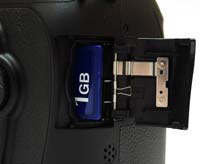 |
 |
| Memory Card Slot | Battery Compartment |
The amount of overlaid information is user selectable, and may include a shooting grid similar to what you can see in the optical viewfinder – but no live histogram, which is a glaring omission that makes Live View much less usable than it could be, and again puts Nikon behind the competition in this area. Photographers who intend to use LV for tripod work will, on the other hand, be delighted to learn that the camera offers mirror lock up – although it is hidden under the cryptically named Custom Function of ”Exposure Delay Mode”.
Live View is also what's used for the feature that has arguably generated the most interest in the Nikon D90: its movie mode. The camera records high-definition, wide-screen video in 1280x720 pixel resolution, at a frame rate of 24fps, in AVI format using the motion JPEG codec. The maximum size of a single video clip is 2 gigabytes which, given that movies occupy about 100 megabytes of storage space per minute, would theoretically translate into about 20 minutes of continuous recording, but – apparently because of certain legal regulations in the EU –, Nikon decided to limit the clip length to 5 minutes for high-definition movies. By offering video capture in a DSLR, Nikon has made it possible for filmmakers to play with depth of field the way they never could, taking advantage of the relatively big sensor and the wide assortment of Nikkor lenses.
Do note however that you cannot set the aperture from the camera in movie mode, so you will want to use lenses that have an aperture ring – that is lenses that do not carry the 'G' designation. Shutter speed cannot be set by the user at all in movie mode, so you will rely on the camera's auto-exposure system while filming, although exposure compensation and AE-Lock can, thankfully, be used. The biggest omission seems to be the complete lack of auto-focus – you have to focus manually. Unfortunately, most AF lenses have MF rings with very little 'travel' between their close-focus point and infinity. The old MF Nikkors are much better in this regard, allowing much smoother and precise manual focusing; but they tend to lack a built-in CPU, meaning the camera cannot meter with them. Overall, the lack of auto-focus combined with the lack of manual exposure in movie mode doesn't seem to be the best combination, and that is an understatement.
It would, however, be a gross mistake to write off the D90 just because its movie mode is a bit rough around the edges. Most other SLRs do not even have this feature after all. And when used as a 'traditional' DSLR the Nikon D90, with its self-cleaning sensor, excellent meter, sophisticated multi-point AF system, large viewfinder, 4.5fps continuous shooting speed, wireless flash options and great degree of cusomisability is hard to beat, especially at its price point. But how does its image quality stack up? Read on to find out...
|
![]() PhotographyBLOG
is a member of the DIWA
organisation. Our test results for the Nikon D90 have been submitted to DIWA
for comparison with test results for different samples of
the same camera model supplied by other DIWA
member sites.
PhotographyBLOG
is a member of the DIWA
organisation. Our test results for the Nikon D90 have been submitted to DIWA
for comparison with test results for different samples of
the same camera model supplied by other DIWA
member sites.
